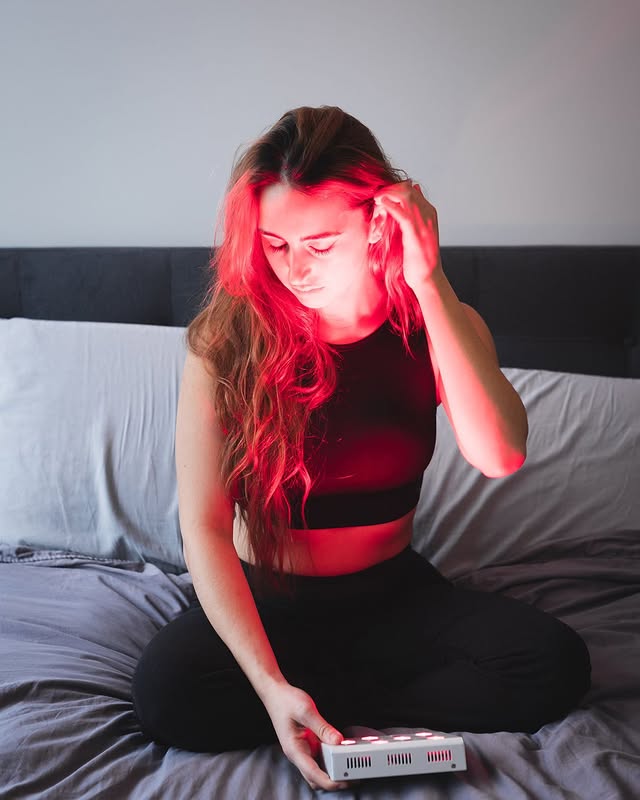![]() Free Shipping
Free Shipping ![]() Buy Now, Pay Later
Buy Now, Pay Later ![]() Eligible
Eligible
How Red Light Therapy Can Alleviate Migraine Symptoms?

Migraines are more than just headaches—they’re debilitating neurological events that can disrupt daily life, causing intense pain, nausea, light sensitivity, and even visual disturbances. For those who suffer from chronic migraines, finding an effective treatment can feel like an endless battle. While medications can help, they often come with side effects or lose effectiveness over time.
Enter red light therapy (RLT), a non-invasive, drug-free treatment that’s gaining attention for its potential to reduce migraine frequency and severity. But how does it work? And is there real science backing its benefits?
In this article, we’ll explore:
- The science behind red light therapy
- How it may help with migraine relief
- Clinical evidence supporting its use
- Practical ways to try RLT for migraines
Understanding Red Light Therapy
Red light therapy, also known as low-level laser therapy (LLLT) or photobiomodulation (PBM), involves exposing the body to specific wavelengths of red and near-infrared light. Unlike UV rays, which can damage skin, these wavelengths penetrate deep into tissues without causing harm.
How Does It Work?
When red and near-infrared light is absorbed by cells, it stimulates mitochondria—the powerhouses of our cells—to produce more adenosine triphosphate (ATP), the energy currency of cells. This boost in cellular energy can:
- Reduce inflammation (a key factor in migraines)
- Improve blood circulation
- Promote tissue repair
- Modulate pain signals in the nervous system
These effects make RLT a promising option for migraine sufferers, particularly those who experience inflammation and poor blood flow as migraine triggers.
The Link Between Red Light Therapy and Migraine Relief
1. Reduces Inflammation in the Brain
Migraines are often linked to neuroinflammation—an overactive immune response in the brain. Studies suggest that red light therapy can suppress pro-inflammatory cytokines while increasing anti-inflammatory molecules, potentially calming the brain’s hyperexcited state during a migraine attack.
2. Improves Blood Flow and Oxygenation
Poor circulation and vascular dysfunction are common migraine triggers. RLT has been shown to enhance nitric oxide production, which helps dilate blood vessels and improve oxygen delivery to brain tissues. This may prevent the constriction and dilation of blood vessels that contribute to migraine pain.
3. Calms Hyperactive Nerves
Migraines involve abnormal electrical activity in the brain, sometimes leading to cortical spreading depression (CSD)—a wave of nerve cell depolarization linked to aura symptoms. Research indicates that red light therapy may stabilize neuronal activity, reducing the frequency and intensity of migraine episodes.
4. Alleviates Light Sensitivity (Photophobia)
Many migraine sufferers experience photophobia—extreme sensitivity to light. Interestingly, red light (particularly in the 660nm range) is less likely to trigger light sensitivity compared to blue or white light. Some studies suggest that controlled exposure to red light may even retrain the brain to tolerate light better over time.
What Does the Research Say?
While more large-scale studies are needed, existing research is promising:
- A 2017 study in Lasers in Medical Science found that transcranial near-infrared light therapy significantly reduced migraine pain in chronic sufferers.
- A 2020 review in Frontiers in Neurology highlighted that photobiomodulation could be a safe, effective adjunct therapy for migraines.
- Anecdotal reports from migraine patients using at-home RLT devices report fewer attacks and reduced pain intensity.
How to Use Red Light Therapy for Migraines
If you’re considering RLT for migraine relief, here are some practical ways to try it:
1. Targeted Light Therapy Devices
- Wearable LED helmets or headbands (designed for transcranial stimulation)
- Handheld red light panels applied to the forehead, temples, or neck
2. Professional Treatments
- Some neurology clinics and pain centers offer specialized RLT for migraines.
- Chiropractors and physical therapists may use red light as part of migraine therapy.
3. At-Home Use Tips
- Wavelength matters: Look for devices emitting 630-660nm (red) or 810-850nm (near-infrared).
- Duration: Start with 10-20 minutes per session, 3-5 times per week.
- Consistency is key: Benefits may take several weeks of regular use.
VELLGUS Elite V2
THE #1 RATED RED LIGHT DEVICE
VELLGUS pro V2
THE #1 RATED FULL BODY RED LIGHT DEVICE
Potential Side Effects and Considerations
Red light therapy is generally safe, with minimal side effects. However:
- Some people may experience mild headache or eye strain if used improperly.
- Avoid staring directly into bright LEDs to prevent eye discomfort.
- Consult a doctor if you have a history of seizures or light-sensitive conditions.
Final Thoughts: Is Red Light Therapy Worth Trying?
For migraine sufferers desperate for relief, red light therapy offers a non-drug, low-risk option with growing scientific support. While it may not work for everyone, its ability to reduce inflammation, improve circulation, and calm nerve activity makes it a compelling complementary treatment.
If you’re tired of relying solely on medications, RLT could be a game-changer. Why not give your brain the light it needs to heal?
Have you tried red light therapy for migraines? Share your experience in the comments!








